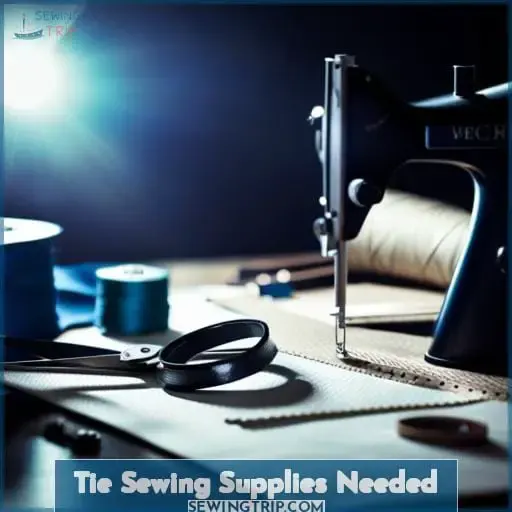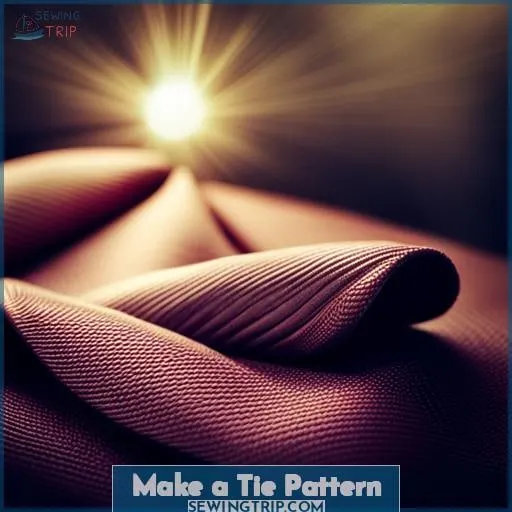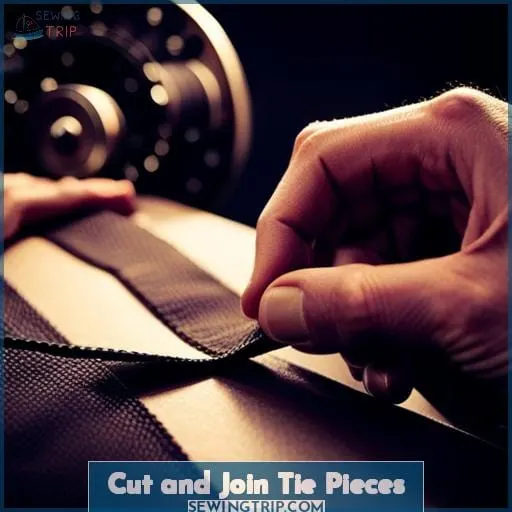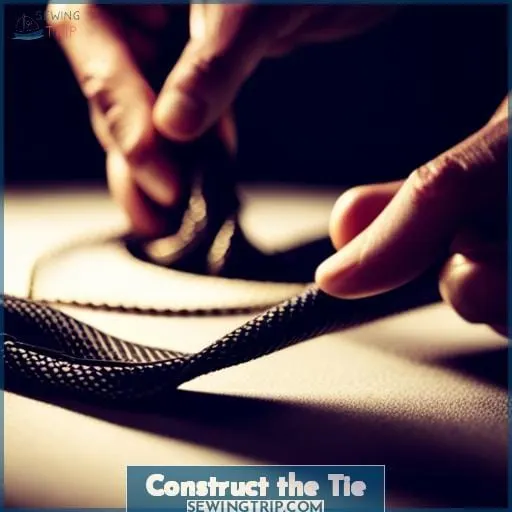This site is supported by our readers. We may earn a commission, at no cost to you, if you purchase through links.
 Fancy yourself a snazzy necktie? Ready to strut your stuff with a dash of panache?
Fancy yourself a snazzy necktie? Ready to strut your stuff with a dash of panache?
Grab your sewing kit and let’s craft a masterpiece.
In this sartorial escapade, you’ll transform a humble piece of fabric into a sharp accessory fit for a kingpin.
Follow these simple steps and you’ll be the envy of all the necktie aficionados.
Get ready to turn heads and leave a trail of admiration wherever you go.
Table Of Contents
Key Takeaways
- Trace an existing tie or use a printable pattern to create the tie pieces
- Cut all fabric pieces on the bias for optimal drape and stretch
- Join the wider base section to the center section with 1/2 inch seam allowances
- Give the tie a polished look by hand-stitching the edges and adding personal touches like embroidery
Tie Sewing Supplies Needed
Before getting started, gather your supplies:
- Fabric
- Interfacing
- Lining fabric
- Basic sewing notions like thread, needles, pins, scissors, and a sewing machine or hand-sewing tools
Having these tie sewing essentials on hand will make the project go smoothly.
Fabric
For your handmade tie, you’ll need fabric with a nice drape, like silk, cotton, or linen.
Opt for a lightweight material that will fold and stitch well. Contrasting prints or solids make excellent lining fabrics to personalize your creation.
Hand stitching gives a bespoke finish.
Interfacing
You’ll also need some medium-weight sew-in interfacing to provide structure and shape to your handmade tie.
- Cut interfacing on the bias.
- Position on tie center.
- Fuse with iron.
Choosing the right interfacing is key for a professional-looking homemade tie. Opt for a midweight woven option, cut on the bias. Position it precisely along the tie’s center, fuse it gently with your iron, and voilà – crisp shape and drape.
Now, let’s move on to lining fabrics and notions to polish off your necktie.
Lining
Having attached the interfacing, you’ll want to include lining fabric when gathering your tie sewing supplies.
Choose a lightweight, soft fabric in a fun print or contrasting color for the lining. This will allow you to showcase a peek of personality when the tie is worn. Consider silk, satin, or even a lightweight cotton.
Cut lining pieces using your pattern and stitch them into the tip ends of the tie in a V-shape before turning right side out.
Notions
One will also need typical sewing notions like thread, pins, needles, scissors, an iron, and a sewing machine to assemble the necktie.
Don’t forget craft paper for drafting the pattern, fabric shears for precise cutting, tie interlining to provide shape, and basic sewing supplies like a hand-sewing needle and matching thread.
With the right notions, one can create sharp neckties from downloaded patterns or by tracing favorite ties.
A few simple seams, tidy pressing, and hand-finishing stitches complete custom neckties to wear.
Make a Tie Pattern
To make your own tie, you’ll need to start with a pattern.
Trace an existing favorite tie using a seam ripper, ruler, and tracing paper.
Or opt for a premade printable tie pattern online.
With the tie outline ready, carefully cut your fabric pieces on the bias following the drawn lines.
Trace Existing Tie
You’re tracing an existing tie to make your tie pattern by carefully unpicking the seams and pressing the pieces flat before tracing them onto paper to create your own reusable template.
This step is crucial in creating a precise and well-fitting necktie.
Using a straight edge ruler, pen or pencil, fabric shears or rotary cutter, you’ll be able to accurately trace all the components of the existing tie onto paper.
This will serve as your guide for cutting out future ties with ease and accuracy.
Use Printable Pattern
You can often download a free, printable tie pattern as an alternative to tracing an existing tie when making a tie pattern.
Select your fabric. Carefully cut the pieces on the bias for optimal drape.
Mark and cut the fabric precisely. Take time to ensure accuracy.
Embellish creatively with embroidery or contrasting fabrics. Make it meaningful.
Hand stitch the edges with care and attention to detail for a polished look.
Cut and Join Tie Pieces
Next, we’ll cut the fabric pieces on the bias and join them together.
Carefully cut your fabric diagonally following the grain for optimal drape and stretch.
Then, pin the wider base section to the center section, right sides together, and machine stitch along the edge with a 1⁄2 inch seam allowance.
Cut on Bias
When cutting out your tie pieces, you’ll want to cut the fabric on the diagonal or bias for optimal stretch and drape.
Use a rotary cutter or fabric shears to cut your main tie pieces, lining, and bias tape on the cross-grain.
Take care to position your pattern pieces properly before cutting.
Cutting on the bias takes a bit more fabric yardage but creates beautiful drape and movement in your handmade tie.
Stitch Main Sections
After cutting out your fabric pieces, stitch your main tie sections together with a 1/2 inch seam allowance.
Carefully join the wider base piece and center base piece, positioning them at an angled alignment. Guide the fabrics under the presser foot, then sew the length with an even seam allowance.
Thoughtfully selecting your fabrics and interfacings lends personalized panache to your handmade necktie.
Construct the Tie
Next, you’ll attach the lining and add interfacing before shaping your tie.
Fold the fabric edges inward and press them flat.
Then, fold the pressed edges toward the center and pin in place.
Attach Lining
Once you have stitched the main tie sections, attach the lining piece in a V shape at the tip using a basic stitch or backstitch if you want extra reinforcement.
Play with different lining fabrics – try a fun print or rich color.
Shape the lining piece based on your tie’s unique style, adjusting the pattern as desired before cutting and sewing.
Customize by adding initials, embroidery, or other personal touches.
Experiment with lining attachments to make each handmade tie special.
Add Interfacing
Often you’ll now add the interfacing down the center of the necktie, tucking it inside the tip lining piece.
Cut interfacing on bias.
Match center placement.
Fuse if needed.
Avoid bulky fabrics.
This anchors the shape. Experiment with lightweight options before selecting the best interfacing.
Fold and Press Edges
So now that you’ve added the interfacing, you’ll fold and press the edges inward before folding again over the center of the tie and pressing once more.
Carefully press the fabric edges inward, then fold them over the center line.
Apply steam and use the tip of the iron to crisply crease the folds.
Check your pressing techniques for clean, sharp edges to achieve stitching precision.
Perfectly pressed folds lend a polished finish when you slip stitch the edges closed in the final step of this DIY necktie project.
Finish Your Handmade Tie
Now that you’ve completed the main steps of sewing your own necktie, it’s time to move on to finishing touches.
One important step is slip stitching the edges for a clean and professional look. This small detail can make a big difference in the overall appearance of your handmade tie.
Additionally, don’t forget to add personal touches such as embroidery or applique if desired, allowing you to truly customize and elevate your creation.
Slip Stitch Edges
You’ll finish your handmade tie by slip stitching the edges.
Carefully hand sew along the folded edge using a slip stitch.
This nearly invisible stitch will neatly secure the layers.
Personalize with embroidery, trim, or other creative touches.
Feel proud wearing your custom neckwear, stitched with care.
Add Personal Touches
You can personalize the tie by adding embroidery, appliqué, or other unique touches.
Consider embroidering initials, a meaningful date, or an inside joke to make it extra special for the recipient.
Play with different thread colors and fonts when monogramming.
Sew on patches, ribbons, or lace using a zigzag stitch to appliqué the tie.
Mix fabrics like silk, cotton, and even leather for an eclectic look.
Have fun with the design process and make it meaningful for the wearer.
Ties make wonderful customized gifts for dads, grads, groomsmen, or anyone who rocks a suit.
Frequently Asked Questions (FAQs)
What width should my tie be?
A tie should be 3 to 31⁄2 inches wide at the widest part.
This width flatters most body types.
It’s not too skimpy or too bulky.
For a custom fit, measure your favorite store-bought tie to match.
Can I use a different fabric instead of silk?
Yes, you can use various fabrics like cotton, linen, or even satin instead of silk.
Just ensure the fabric has enough body and drape to achieve the signature tie shape.
Interfacing helps lightweight fabrics hold that recognizable form.
How long does it take to make a tie?
Simply speaking, how long it takes to make a tie will depend on your skill level.
Allow 2-3 hours for your first attempt, less when you gain experience.
Work carefully and don’t rush the process – relax and enjoy bringing your custom neckwear to life!
Can I add embroidery or other decorative details?
Yes, you can absolutely personalize your handmade tie by adding embroidery, appliqué, or other decorative details.
Have fun making the tie unique with contrasting thread, initials, small motifs, or even jewels if you want some extra sparkle.
The possibilities are endless, so embrace your creativity!
What is the best way to press my finished tie?
Let’s press the tie with care to achieve a professional look.
Lay it flat, cover with a press cloth, and apply a medium iron temperature.
Avoid over-pressing or risk flattening the shape.
A perfectly pressed tie completes your handmade creation.
Conclusion
Whether crisscrossing a spread collar or nested beneath a jacket’s lapel, your suave DIY tie will add panache to any ensemble.
Juxtaposing your creativity against store-bought alternatives, you can fashion this small strip of fabric into a personalized statement piece.
Following our simple steps to sew a tie, you’ve crafted practical elegance from scratch.
So grab your handmade neckwear—custom-fitted and budget-friendly—and stride with savvy into any soiree.











